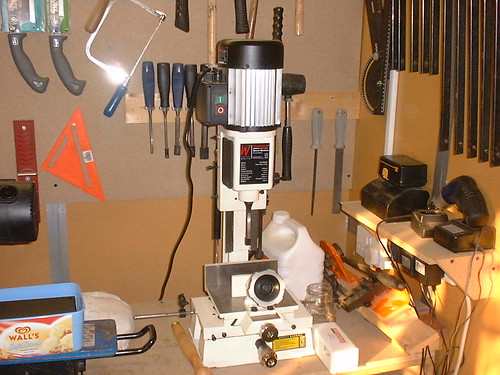Well I have found myself cutting a lot of mortices recently and have been using my router quite happilyto get nice smooth mortices that I just square the ends with with some nicely sharpened bench chisels....This is just a hobby for me at the moment but I am getting quite a few requests from friends for making this and that...Mainly stuff for outside like Horse mounting blocks and rabbit hutches and stuff like that...Now I know not all of these jobs require M&T's but I like the joint and it can't be beaten for strength...
With my current mounting block design I have to cut 24 mortices so I was seriously considering buying a benchtop morticer..
The Axminster one mentioned above seems like the best bang for the buck, especially with the sliding table so I just wondered whether anyone had any experience of this morticer.
As I am mainly working in 47x75 (2x3 ish) pressure treated wood I will want to be using the biggest chisel it takes which is the 16mm I believe..but will that be too taxing for it?
The model above only comes with the one chisel and whilst I see I can buy a set from axminster for approx £30 are these the best ones to get or should I find a really decent 16mm chisel and just buy that instead..
Would really appreciate some advice with this one...Also..if anyone has one that they hardly use and want to sell on second hand then please get in touch also...
I do not want to spend more than I have to because like another Tim on here we have also applied to emigrate to Canada and hoping that might come through next year sometime and anything electric will have to stay...
Thanks for any advice / suggestions..
Cheers
Timmo
With my current mounting block design I have to cut 24 mortices so I was seriously considering buying a benchtop morticer..
The Axminster one mentioned above seems like the best bang for the buck, especially with the sliding table so I just wondered whether anyone had any experience of this morticer.
As I am mainly working in 47x75 (2x3 ish) pressure treated wood I will want to be using the biggest chisel it takes which is the 16mm I believe..but will that be too taxing for it?
The model above only comes with the one chisel and whilst I see I can buy a set from axminster for approx £30 are these the best ones to get or should I find a really decent 16mm chisel and just buy that instead..
Would really appreciate some advice with this one...Also..if anyone has one that they hardly use and want to sell on second hand then please get in touch also...
I do not want to spend more than I have to because like another Tim on here we have also applied to emigrate to Canada and hoping that might come through next year sometime and anything electric will have to stay...
Thanks for any advice / suggestions..
Cheers
Timmo





